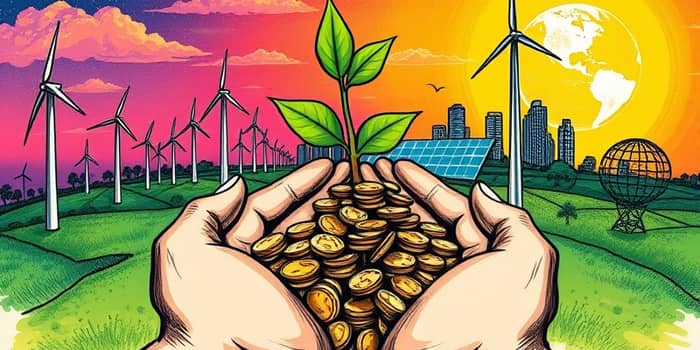Environmental, Social, and Governance (ESG) investing has evolved from a niche strategy into a mainstream approach that empowers investors to achieve financial success while contributing to positive global change. By marrying rigorous analysis with ethical considerations, ESG strategies have proven that it is possible to align investment goals with values without sacrificing performance.
As we approach pivotal regulatory shifts in 2025 and witness a surge in sustainable innovations, the time is ripe to explore how ESG investing can deliver long-term resilience and growth for portfolios and the planet alike.
The Rise of ESG Investing
Over the past decade, sustainable investing has gained significant momentum. Global assets managed under ESG principles have surpassed $30 trillion, reflecting a wave of investor demand for responsible corporate behavior.
ESG investing incorporates factors such as climate change, resource management, worker rights, board diversity and ethical leadership into financial analysis. By doing so, investors identify companies that are better positioned to navigate regulatory changes, societal expectations and environmental challenges.
According to recent research, 54% of corporations now include ESG considerations in their risk reporting, underscoring the deep integration of sustainability into corporate governance.
Performance and Value Creation
One of the most compelling arguments for ESG investments is their demonstrated capacity to outperform traditional counterparts while mitigating risk. Morningstar data shows that over 10 years, 58.8% of sustainable funds outperformed comparable conventional funds. Meanwhile, the JUST U.S. Large Cap Diversified Index delivered a 15.94% annualized return versus the Russell 1000’s 14.76%.
Institutional research from Morgan Stanley found that from 2004 to 2018, ESG funds achieved similar or better returns than standard funds with significantly lower downside deviation. Furthermore, 77% of ESG funds remained active over a decade, compared to just 46% of non-ESG funds, illustrating their remarkable market longevity and stability.
Key Trends Shaping 2025 and Beyond
The ESG landscape is evolving rapidly, driven by regulatory, technological and market forces. Investors should pay close attention to several emerging trends:
- Stricter global ESG frameworks: Europe is set to implement enhanced reporting standards in 2025, while U.S. policies may see increased debate and fluctuation.
- Accelerated green bond issuance: Lower interest rates are expected to spur the growth of green, social and sustainability-linked bonds.
- Rise of nature-positive solutions: Biodiversity investments and natural capital markets are emerging as critical components of sustainable portfolios.
- AI-driven ESG analytics: Artificial intelligence enhances data processing but also introduces new ethical and governance challenges.
In parallel, thematic areas such as renewable energy, electric mobility and decarbonization projects continue to unlock vast potential, with estimates indicating more than $3 trillion in investment opportunities tied to China’s clean air initiatives by 2030.
Navigating Challenges and Avoiding Greenwashing
Despite its promise, ESG investing faces hurdles. Inconsistent reporting frameworks—ranging from SASB and GRI to TCFD—can lead to data disparities and comparability issues. Investors must perform rigorous due diligence and independent ratings to separate genuine impact strategies from superficial claims.
Greenwashing remains a serious risk. Without standardized definitions and enforcement, some funds exaggerate their sustainable credentials. Prudent investors should verify:
- Third-party ESG ratings and certifications.
- Specific fund holdings and engagement records.
- Clarity on net-zero targets and decarbonization pathways.
Practical Strategies to Align Profit and Purpose
To capitalize on ESG opportunities, investors can consider a range of vehicles and approaches. Below are actionable strategies:
- Core sustainable funds: Choose well-established mutual funds or ETFs with transparent screening methodologies.
- Thematic portfolios: Allocate capital to specialized vehicles targeting climate solutions, water stewardship or gender equity.
- Green and social bonds: Invest in fixed-income instruments that finance specific environmental or social projects.
- Active engagement: Employ shareholder advocacy to influence corporate practices and promote better disclosures.
- Direct partnerships: Explore private equity or venture capital opportunities with firms committed to measurable ESG impact.
By integrating these strategies, investors can build diversified portfolios that balance return objectives with measurable societal benefits.
Quantifying ESG Benefits: A Summary Table
Conclusion
ESG investing stands at the intersection of financial performance and societal progress. As data consistently shows, sustainable strategies not only can deliver competitive returns with lower risk but also help build a more equitable and environmentally resilient future.
With regulatory reforms on the horizon, technological innovations accelerating analysis, and public awareness pushing companies toward greater responsibility, investors have an unprecedented opportunity to shape corporate behavior while safeguarding their portfolios.
By embracing ESG principles, conducting thorough due diligence, and selecting the right mix of funds, bonds and engagement tactics, individuals and institutions alike can truly realize the promise of profit with purpose. The journey toward sustainable prosperity begins today, and the potential rewards—for people, planet and portfolios—are immense.
References
- https://www.investopedia.com/terms/e/environmental-social-and-governance-esg-criteria.asp
- https://www.financealliance.io/7-benefits-of-esg-investing/
- https://www.cfainstitute.org/insights/articles/what-is-esg-investing
- https://us.rbcwealthmanagement.com/documents/170410/170426/18-WG-774_Etergino+Group_Benefits+of+ESG+Investing+Flyer_evite.pdf/2f645a56-155e-4b55-8bc2-3e1a61fc84b6
- https://www.nerdwallet.com/article/investing/esg-investing
- https://connect.sustainalytics.com/six-sustainable-investing-trends-to-watch-in-2025-report
- https://www.mckinsey.com/capabilities/strategy-and-corporate-finance/our-insights/five-ways-that-esg-creates-value
- https://greenly.earth/en-us/blog/company-guide/esg-investing-meaning-and-trends










